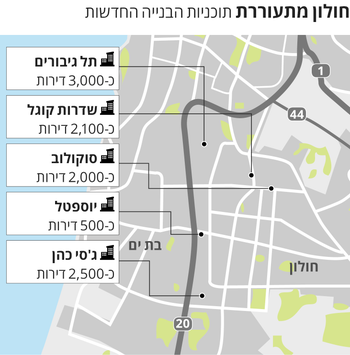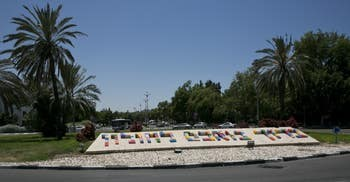The Marker, Gili Melnitsky, 20.08.2020
Entrepreneurs of urban renewal working in Holon in recent years have promised sweeping additions to property owners, both in addition to space for apartments and in parking areas. But a new line led by the Holon municipality is expected to lead to the opening of contracts with tenants and opposition from developers, which were not properly prepared for the vision of urban renewal, and some will be required to re-examine the viability of projects, which are in jeopardy. In Holon, six evacuation-construction complexes are being promoted, which will add about 8,550 housing units, and in the center is a huge project in the Kugel Boulevard complex - indicating some of the principles that will guide the city's renewal.
The outline presented to the complex's occupants and developers indicates that the parking standard to be dictated by the local planning committee in the Kugel complex will be only 0.7 parking spaces per apartment, and that public parking will be integrated in the underground car parks of the buildings - to be used by theater guests. The reduction of parking areas joins the limitation of the consideration for the existing apartments, to only 12 square meters (not including a balcony), along with the expropriation of significant parts in favor of the green line of the light rail that will pass through its center.
The new policy of the Holon Municipality and the Government Authority for Urban Renewal , which is involved in planning the Kugel complex, currently dictates a multiplier of 1: 3 - 1: 4 - that is, three to four new housing units for each unit to be demolished - while some Holon activists claim economic viability Requires to build four to five apartments in place of each unit. There are 844 housing units in the complex, and at least 2,100 apartments are expected to be built in their place.

The planning for the complex on Kugel Boulevard also affects Kaplan, Yitzhak Sadeh, H. Bayer, Gilad, Hagalil, Avivim and Mikve Israel roads. This complex was designed as a "community avenue", in which the facades of the new buildings are expected to include mainly public lower floors - both traffic centers and community offices, as well as educational and cultural institutions - along with relatively low-volume commercial uses and office buildings. The municipality demands that areas that are rehabilitated for public needs and the well-being of the tenants be built at the developer's expense up to the level of a shell.
The change led by the Holon Municipality in parking standards joins a similar policy recently adopted by the Tel Aviv Local Planning Committee. According to Holon city architect Aviad Moore, the policy is based on planning guidelines along the mass transit routes, which are implemented in the area:
"The plan sees the space around the train station as a vessel that crowds and enlarges the community, but also expands the services provided to it. Proximity to the station will make it possible to make the required perceptual change also by reducing the parking standard. "Policy of the Tel Aviv District Committee, and we believe in its justification."
The municipality clarifies that the reduced parking standard will apply to complexes near mass transit routes, and that in the rest of the city the policy is expected to be slightly more generous - one parking space per apartment. But despite the municipality's great trust in the new line - the developers are criticizing it.
 The entrance to the city of Holon Photo: Ofer Vaknin
The entrance to the city of Holon Photo: Ofer Vaknin
For example, according to the plan, the average apartment space in the project that Tidhar is promoting in the complex will be about 118 square meters, and some of them will be sold
without parking. "This is a problematic figure for implementation. "1: 5 multiplier instead of 1: 4 and an average apartment area of 89 square meters with a parking standard 0.7, which is problematic as well, but more applicable," Tidhar representatives wrote to the municipality.
Adv. Keren Fresher from the firm of Raz-Cohen Fresher & Co., which represents apartment owners in the area, says that even in these projects the average apartment area will be about 122 square meters - but some will be without parking. "These are large apartments for families and some will be sold without parking at all. This is absurd and it is a challenge that few developers will face. This is an unreasonable standard for an apartment of this size, so the Holon municipality should allow developers to build more small apartments, which may be sold without parking. ".
The municipality explains that the planning should include small apartments of 2-3 rooms for them, amounting to about 40% of all apartments. Liran Edri, head of the Holon Urban Renewal Administration , explains that many of the residents of the Kugel complex live in small rented apartments, and that the residents - adults or students - rely more on public transportation, hence the importance of preserving them.
Meanwhile, tenants have also commented on the new outline. Tenants' representatives in one of the complexes express opposition, and in a letter sent to the municipality, the property owners said: That the underground parking lot will be part of our private property and will be used by us. "
Their approach raises a significant issue concerning planning and ownership of the underground, which will affect many cities in the Tel Aviv metropolitan area. When Holon joins the Tel Aviv municipality, which announced the reduction of the parking standard, the two cities will be required to deal with property registration issues accordingly - as they seek to manage the parking lots themselves and reduce the mechanism that was accepted until today of specific linkage to parking.
Guri Nadler, from the Renewal Authority, which has invested NIS 13 million in recent years in promoting urban renewal programs in Holon, explains:
"Maybe the change brought down projects"
The new situation in Holon puts developers in an awkward position, with some being forced to change contracts with property owners. Among other things, the municipality intends to collect a full improvement levy, oblige the designation of some of the apartments for long-
term rent, and ensure maintenance fund payments to returning tenants - which will play the entrepreneurial profit.
Nadler says that in some cities contracts have already been reopened and the permits updated - subject to changes required by a local or district committee. He said, "It may have knocked down projects, but that does not mean there is no economics even in an extra 12 square meters. Even if entrepreneurial profit is reduced, that does not mean the project will not come out. This means that when he leaves, the permits will be fair to everyone: the tenant, the developer and the local authority. "
Fresher adds that “there are already developers who have promised returns of 30 square meters and this decision could cause a shake-up. In addition, considerable areas are designated for offices and employment - and the value of a square meter of employment for an entrepreneur is much lower than housing, especially in the Corona era.
Another issue raised by entrepreneurs involved in organizing in the area concerns public exchanges and the construction of public buildings, which erode entrepreneurial profit - for example, the establishment of a school.
Holon Mayor Moti Sasson says that this is a worldview that seeks to put the needs of the local authority and residents at the center of the process: "Holon is an example of informed and responsible conduct. We are required to address the density of cities in areas of demand, "The only consideration in making decisions. The municipality does not leave the fate of the city only to the private market - and it initiates and leads programs with the participation of residents and other stakeholders."



